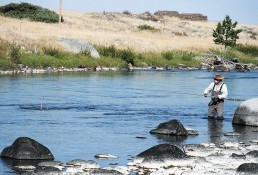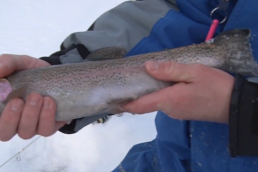Trout Want What Old-timers can Deliver
SHARE THIS POST
Genetics seems to be the solution to everything these days. Back when I took high school biology, no one had ever heard of genes. Now, manipulate the genes of some plant or animal and get disease-resistant corn- or fat-free beef, and that’s progress no matter how you look at it.
As trout anglers age, some of their needs change. While it is too late to manipulate the genes of some of my angling buddies (or me), now might be just the time to begin developing a strain of trout, a genetic manipulation we might call “geezer preference.” These trout would have the genetic qualities to assure my friends could catch trout like they used to (or remember they used to).
For one thing, the geezer-preference trout would not strike at flies smaller than, say, size 14. Even with a parachute dry fly tied with a fluorescent post, a number 20 blue wing olive drifting down a stream on a typical blue wing olive day is virtually invisible. Sometimes the only indication a trout has grabbed a fly is a tug on the line. How many strikes are missed? No one knows.
Further, tiny flies are ever more difficult to tie on tiny tippets. The next time I visit Dr. Sie, I’m going to show her a number 20 gold-ribbed hare’s ear and a piece of 7X tippet and tell her, “I want to thread this through this hole.”
Fishing in Montana a while back I noticed my buddy Bill kept going back to the lodge every half hour or so. When I asked why he returned so often, he told me he wanted the 20-year-old waitress to tie on a new fly for him.
Geezer-preference trout would like gaudy flies. A friend suggested green drakes would be suitable. What I had in mind was more along the lines of an orange drake.
And these genetically modified trout would strike deliberately. So often a rainbow appears from nowhere, slashes at a drifting dry fly and disappears before a geriatric angler can respond. In addition to the difficulty in hooking such rapidly striking trout, there is a danger to anglers as well. Dale, one of my angling buddies, tumbled backwards into the stream trying to set the hook on a striking trout in a North Carolina mountain stream.
Bass anglers claim that if a largemouth bass grabs a Texas-rigged plastic worm and holds on for three seconds the typical angler can successfully set the hook. Given the limitations of bass anglers, trout fisherpersons would not need so lengthy of time. Geezer-preference trout should be genetically engineered to grasp a fly 2.5 seconds, with a standard deviation not to exceed half of a second.
Are you enjoying this post?
You can be among the first to get the latest info on where to go, what to use and how to use it!
With more and more anglers practicing catch-and-release and more states adopting delayed harvest to spread the availability of trout fishing—except for deep wilderness fish—trout seem to be getting smarter every day. The day of “dumb” trout just dropped off the hatchery truck has passed me by. Geezer-preference trout would have short memories. Simply because a 14-inch brown got caught on Tuesday on a size 10 Adams, it would not mean the same fly wouldn’t work on Wednesday. Maybe trout research could be tied to Alzheimer’s disease research in humans—diminished memory in the one and enhanced memory in the other.
While we would still want trout to lie in current breaks—spots ancient anglers have learned over the years harbor trout—geezer-preference trout would seek substrates where the rocks were not covered with slick algae. The Big Hole River and Rock Creek, both in southwestern Montana, are beautiful streams teeming with trout. Like many other trout streams across the country, wading these streams is a constant struggle. From direct and personal experience, I can attest the water in those streams is cold. An early morning dip in a trout stream can ruin a day’s fishing.
This trout would also be genetically manipulated to streams with a modest gradient. What would be appropriate? Certainly any stream where a senior angler can see the water is running downhill, swirling around rocks and into deep holes, is too swift. Stream trout are toughened by current, no doubt. Yet, there ought to be a limit.
A couple of months ago, Bob Martin alerted me to another danger of swift water. Bob is not yet a geezer, but he’s getting close. We were fishing a stream eager to get somewhere else where the bottom was covered with slick, round rocks. When we met at the truck for lunch, Bob told me he lost the studs off his boots. “No way,” I told him, “those things are screwed in tight.” I was wrong. Bob lost most of the studs off both boots. That could pose a real threat to a geezer.
Of course, a careful angler can get a wading staff. Bill bought a shock-corded collapsible pole at a yard sale. He used it as an aid to wading. It was completely white. I accused Bill of trying to fool the trout into thinking he was blind and they could strike his fly with impunity. He merely wanted to take advantage of me. He denied, as I expected, the merit of my analysis.
Geezer-preference trout would not be leader shy. When a couple of extra false casts are required to dry off a favorite fly, perhaps even after the fly caught a fish, trout would not head for the nearest log jam or undercut bank. How many times has the first hint I had trout around and it became the news flash to the fish as they headed for cover?
In order to protect genetically specialized trout, special sections of streams would need to be set aside for senior anglers. Sort of like catch and release, flies only, delayed harvest and other restricted portions. From time-to-time, of course, trout from other areas would infiltrate the geezer sections. Consequently, there would always be the possibility that a savvy, leader shy, midge sipper might appear. Such fish would merely add to the challenge.
MWO
SHARE THIS POST
You may also like...
Did you enjoy this post?
You can be among the first to get the latest info on where to go, what to use and how to use it!
MWO
We believe being outdoors is good. With more than 1,000 articles each year, MidWest Outdoors magazine is all about sharing outdoor experiences with you—where to go, what to use and how to use it… whether you’re close to home or on that trip of a lifetime.


